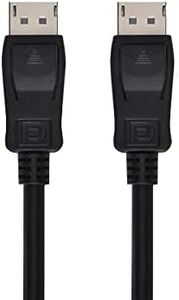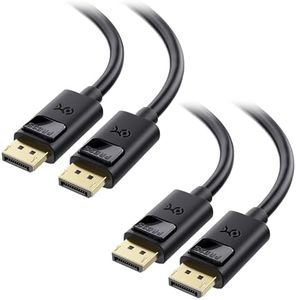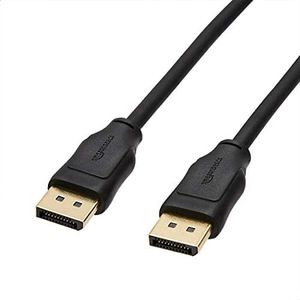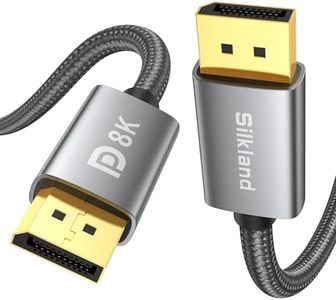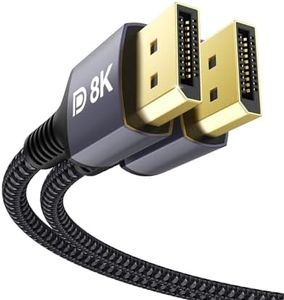We Use CookiesWe use cookies to enhance the security, performance,
functionality and for analytical and promotional activities. By continuing to browse this site you
are agreeing to our privacy policy
10 Best Display Port Cables
From leading brands and best sellers available on the web.By clicking on a link to a third party's website, log data is shared with that third party.
Buying Guide for the Best Display Port Cables
When choosing a DisplayPort cable, it's important to understand what features matter most for your setup. DisplayPort cables are commonly used to connect computers to monitors, especially when you need high resolutions and refresh rates. The right cable ensures you get clear images, fast response times, and stable connections. Start by knowing what your computer and monitor support, and match the cable to those needs.VersionThe version refers to the generation of DisplayPort technology supported by the cable, usually labeled as 1.2, 1.4, or 2.0. Each version supports different maximum resolutions, refresh rates, and features; for example, higher numbers offer greater support for 4K or 8K displays, faster data transfer, and sometimes features like HDR. If your setup includes a high-resolution or high-refresh-rate monitor, opt for a cable that matches the version supported by both your monitor and graphics card. Otherwise, if you're using a basic monitor, a lower version is sufficient.
BandwidthBandwidth describes how much data a cable can carry at once, directly affecting image quality and refresh rates. Higher bandwidth is needed for higher resolutions, faster refresh rates, and extra features like audio or daisy chaining multiple monitors. Common bandwidth values depend on the DisplayPort version, so choosing a cable with high enough bandwidth ensures your monitor performs at its best without screen flickering or blackouts.
Cable LengthThe length of the cable is simply how far it can reach from your computer to the monitor. Shorter cables (under 2 meters) typically maintain better signal quality, while longer cables (over 3 meters) might require higher quality or active cables to prevent signal loss. Consider the distance between your devices and pick the shortest cable that comfortably fits to minimize the risk of signal problems.
Connector Type (Standard vs Mini)DisplayPort cables come with either a standard or a Mini DisplayPort connector. The plug shape and size are different, and it's important to match the connector type to your devices' ports. Standard connectors are more common on desktops and larger monitors, whereas Mini DisplayPort is often found on laptops or tablets. Check both your source and display devices to see which connector you need.
Build QualityBuild quality refers to the materials and craftsmanship of the cable, affecting durability and reliability. Look for cables with secure connectors and robust insulation, especially if you’ll be plugging and unplugging often or running the cable behind furniture. Poorly made cables might work at first but can wear out faster or cause random connection issues.
Certifications/ComplianceSome DisplayPort cables are certified to meet certain standards, ensuring they deliver the promised performance and safety. Certified cables have been tested by industry groups, so they're less likely to give problems with compatibility or quality. If you want extra peace of mind for demanding setups, look for certification labels, though for basic use, non-certified cables might still meet your needs.
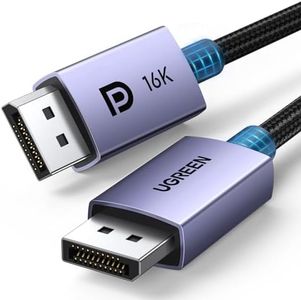
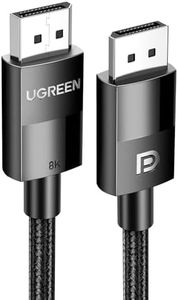
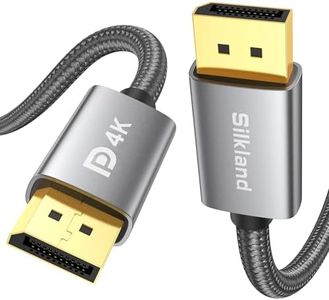
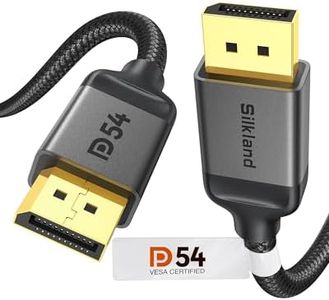
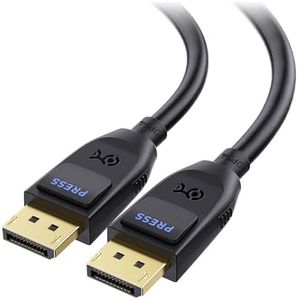

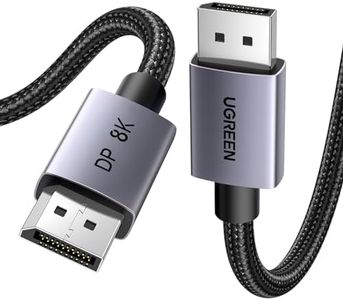
![DisplayPort Cable 1.4, Tunghey 8K 4K DP Cable, Display Port Cord [8K@60Hz, 4K@144Hz, 2K@240Hz, 32.4Gbps], High Refresh Rate for Gaming Monitor, HBR3, HDR (1M)](https://images-proxy.bestreviews.guide/vLZJfACuC5VIlWqLR4Tf5y8DDew=/0x300/https://m.media-amazon.com/images/I/414JnoIH-4L._AC_CX679_.jpg)
![[VESA Certified] Cable Matters 80Gbps DisplayPort 2.1 Cable - 2m, 16K Display Port Cable 2.1, DP80 Cord for 16K@60Hz, 8K@240Hz, 4K@240Hz with FreeSync, G-SYNC and HDR](https://images-proxy.bestreviews.guide/MZuR6NKLeQ6SX16OlxpUq8OIKI0=/0x300/https://m.media-amazon.com/images/I/41jZywVptuL._AC_CX679_.jpg)
